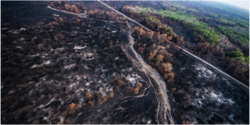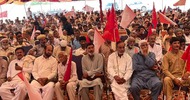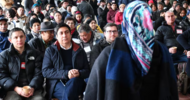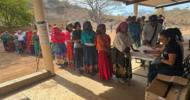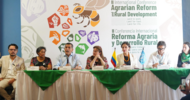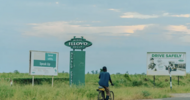WRM Bulletin | 2 December 2021
Agribusiness means fire: Land grabs, deforestation and fires in the Amazon, Cerrado and Pantanal biomes
Five perspectives to understand the forest fires that have afflicted Brazil in recent years.
In August 2019, landowners agreed among themselves to set fire to the Brazilian Amazon forest, specifically in the southwest of the state of Pará, in what became known as Fire Day. On the following year, more to the south, fires were started in cattle ranches that supply beef to major meat packing operations. (1) These spread quickly and burned 4.1 million hectares of the Pantanal, (2) an area of wetlands that crosses the border into Paraguay and Bolivia.
Over the last three years, socio-environmental devastation has been at the heart of the Brazilian public agenda, while we watch, astounded, as the government lies about the causes and about its own responsibility on the matter.
Data monitored by the National Institute of Space Research (INPE) indicate that in March 2019, Brazil had the largest number of fires in the historical series, started in 1998, totaling 5213 fires. April 2020 also beat the record for that month, with 4117 fires.
And this setting is not just a Brazilian reality. In 2020, the dynamic of fires across South America worsened, with the largest numbers since 1998 for the months of March (31,529), April (23,139) and May (15,070).
Beyond the satellite images and numbers about fires and deforestation, it is important to refine the debate: on the one hand, by raising the dimension of lived experience on the ground, in forest areas and other hinterlands; on the other, by pointing out what is behind the fire and the chainsaw, and its relation with agribusiness.
In this text, we present five perspectives considered fundamental in the articulation Agro é Fogo (Abribusiness means Fire), (3) a coalition of movements, organizations and social pastoral bodies that have worked for decades in defense of the Amazon, Cerrado and Pantanal biomes and their peoples and communities.
1) Forest fires and deforestation are tools to consolidate the land grabbing that goes hand-in-hand with the expansion of the capitalist agricultural frontier into the territories of indigenous peoples and traditional communities.
Deforestation and fires are usually addressed as problems merely of an environmental nature. However, deforestation operates as a tool of the private appropriation of land and, therefore, is concentrated in undesignated public lands, precisely the areas prone to land grabs. (4) It is the potential regularization of the area appropriated – through amnesties historically granted in Brazil to land grabbers and deforesters via various normative changes – that makes this process viable. Such changes were speeded up after the 2016 coup, and have become even more intense during the government of Jair Bolsonaro. (5)
All these areas of forest and other wilderness into which capital is trying to advance are territories belonging to countless indigenous peoples and traditional communities that inhabit and protect them. In many cases, they have not had their territorial rights recognized. Therefore, it is impossible to address the environmental question in Brazil decoupled from the agrarian and the land questions. On the contrary: in the light of this understanding, agrarian reform – including officializing traditional territories with deeds – becomes not just a question of ethics and rights, but also an ecological imperative.
2) Agribusiness’s chain of relations is global and there are shared responsibilities with regard to the devastation in the territories. However much market environmentalism tries to promote the greenwashing of the commodities that Brazil exports, the globalized agro-food system controlled by a few highly financialized transnational corporations is intrinsically unsustainable.
Brazil’s export economy is extremely dependent on agribusiness, which occupies spaces of power and controls a narrative of vigor. Every day on the country’s largest television network, we watch ads saying “Agro is pop, agro is tech, agro is great!”. For all the talk of technology, over the last few decades, agribusiness has expanded in production volume much more owing to the expansion of the agricultural frontier than to increased productivity. In this sense, modern agribusiness depends, as it always has done, on the invasion of public lands in order to establish its territory. It does so by means of the organized crime of land grabbing and the plunder of timber, with intense use of slave labor and grotesque fraud. (6) At the same time, in a vicious cycle, it maintains a relation of extreme dependence on the State, which, within this logic, always has to be at its service.
This chain of relations is global and connected to agro-industrial giants – from meat packers and grain processors to major laboratories, fertilizer and agro-chemical manufacturers, all the way to the exporters –, and leaves a large share of Brazilians in a situation of food insecurity, even though the country is one of the world’s top agricultural producers. It is more and more diffuse and financialized, as in the case of the international pension funds (7) that invest in grabbed lands in the Brazilian Cerrado biome, obscuring their shared responsibilities. The trail of fire left behind by Brazilian agribusiness is global, and a critique of the unsustainability of the commodities that dominate the globalized agro-food system should also come from other parts of the world.
3) The agribusiness chain has always used fire to conduct deforestation, land grabbing and territorial control, but with the bolsonarista additive there has been a greatly enhanced use of fire as a weapon to threaten and drive out peoples and communities from their living territories.
Historically, fire has been used in these processes as a veritable weapon of territorial control against peoples and communities, seeking to expel them from their traditionally occupied lands. (8) However, there has been a clear intensification of attacks using fire along the frontlines of the bolsonarista project of destruction: president Bolsonaro encourages the illegalities perpetrated by his followers. The so-called Fire Day along the axis of highway BR-163 in August 2019 probably is the most flagrant expression of this, but not an isolated incident. In order to exemplify this, let us point out some cases in different regions of the country.
In the state of Piauí, in an area of Cerrado, (9) the Gamela Indigenous Land sits along the expanding agricultural frontier. The community has been suffering from the effects of several criminal fires set by land grabbing soya producers: in 2017 and 2020, houses were burned down, and in 2021, fences were destroyed, property removed, a warehouse belonging to a local family was set on fire and death threats were made.
In the center-west region of Brazil, along the old agricultural frontier between the Cerrado and the Pantanal, the overwhelming fires of 2020 burned more that 211,000 hectares of the Kadiwéu Indigenous Land, 39.15% of their territory. In the riverine community of Barra de São Lourenço, three families had to be rescued by the fire brigade and some 25 families spent days having to cope with muddy waters, full of ash.
In the so-called “Deforestation Arc”, an area of transition between the Cerrado and Amazon biomes, sits the Parque Indígena do Araguaia Indigenous Land in the state of Tocantins, where there reside 3500 members of the Avá-Canoeiro, Iny Karajá, Javaé and Tapirapé indigenous peoples, as well as isolated groups. This area was among the ten worst affected indigenous territories in the Amazônia Legal region by the fires of 2019. In 2020, this indigenous land had 8792 hotspots, and again in 2021, fires have destroyed what was left of the vegetation.
The forest fires are expressions of territorial conflicts. The reason we have some of the Pantanal, the Cerrado and the Amazon still standing is because indigenous peoples and traditional communities have fought tirelessly to hold on to their territories. And it is the management done by these peoples and communities that preserves the forests and multiplies their socio-biodiversity.
4) Fire is an element of nature managed with wisdom and care by indigenous peoples and quilombola, traditional and peasant communities in the Amazon, Cerrado and Pantanal for millennia, an increasingly criminalized practice.
Bolsonaro’s speech to the UN General Assembly in September 2020, during which he said that it is “the caboclo and the indian” that set fire to the forest, is obviously a cynical smokescreen to deflect attention from the origin of the criminal forest fires. The word caboclo was used by the president to refer to descendants of indigenous people. Even among those who stand in solidarity with the struggles of indigenous peoples and traditional communities, there is a lack of knowledge and some prejudice about coivara agriculture (or roça de toco) and other uses of fire in traditional systems. (10)
These systems are keepers of a sophisticated connection with millennia-old knowledge, developed and adapted by the ancestors of these peoples and communities. In this sense, they are part of the long-term management of agro-forest landscapes characterized precisely by high levels of biodiversity, as well as feeding and providing an income for thousands of families. Especially in the Cerrado, the management of biomass allows fires to be prevented. Such knowledge has been brought by indigenous members to forest fire brigades as part of programs from environmental agencies. (11) This whole wealth of knowledge must be valued and respected, rather than stigmatized and criminalized, as has been happening. They are uses of fire implemented with care and reverence for this element of nature, as opposed to the capitalist fire – directly or indirectly associated with the cycle of deforestation and land grabbing.
5) The intensification of deforestation and forest fires in the last two years has to be understood as a common challenge in the defense of the Amazon, the Cerrado and the Pantanal biomes.
Lastly, there is a socio-metabolic relation between the Amazon, the Cerrado and the Pantanal. The history of devastation of the Cerrado puts pressure on the expansion of the agricultural frontier toward the Pantanal and the Amazon. And the devastation of more than half of the Cerrado, especially on the plateaus where rivers have their sources – rivers that flow toward various hydrographic basins –, has everything to do with the water shortage in several regions of the country and with the low water level in the Pantanal flood plain. Let us not forget that the Paraguay River has its source in the Cerrado, floods the Pantanal and flows through other countries in the region.
In other words, the defense of the Amazon, the Cerrado and the Pantanal are connected. The Agro é Fogo coalition understands this and, therefore, is building a common fight. Now we are trying to enhance this dialogue with South American allies, since this socio-metabolic web obviously extends beyond Brazil’s borders to other Amazonian countries, to the Chaco and to the Bosque Seco Chiquitano, where intense fires have also taken place in the wake of the expansion of the agricultural frontier.
Diana Aguiar, Social Sciences post-doctoral researcher in Development, Agriculture and Society (CPDA) of the Federal Rural University of Rio de Janeiro (UFRRJ), and advisor to the National Campaign in Defense of the Cerrado.
Bárbara Dias, executive secretary of the Agro é Fogo coalition and PhD candidate in Social Anthropology at the National Museum of the Federal University of Rio de Janeiro (MN/UFRJ).
Carolina Motoki, research coordinator of the Agro é Fogo coalition and advisor to the National Campaign to Prevent and Combat Slave Labor of the Pastoral Land Commission.
Valéria Pereira Santos, Pastoral Land Commission organizer for the Cerrado; holds a master’s degree in People’s Demands and Regional Dynamics from the Federal University of Tocantins (UFT).
(1) https://reporterbrasil.org.br/2020/09/fogo-no-pantanal-mato-grossense-comecou-em-fazendas-de-pecuaristas-que-fornecem-para-gigantes-do-agronegocio/
(2) https://lasa.ufrj.br/noticias/area-queimada-pantanal-2020/
(3) http://www.agroefogo.org.br
(4) For more on the relation between deforestation and land grabbing, see here.
(5) In this article there is a timeline showing how legislation has facilitated the actualization of land grabs.
(6) About the relation between deforestation, land grabbing and slave labor, check this and this article.
(7) In these articles you can read about the relation between the State and agribusiness, and what this implies. See here and here.
(8) In the No Rastro do Fogo section, you can follow the various conflicts systematized by the platform, where fire is used as a weapon to grab public lands, intimidate and expel traditional communities and peoples.
(9) In order to demonstrate more concretely the intensification of the use of fire as a weapon against the peoples and traditional communities of the Amazon, Cerrado and Pantanal in recent years, we resorted to the database on conflicts in the countryside of the Pastoral Land Commission and the territorial conflicts contained in the Agro é Fogo dossier.
(10) About fire management among traditional communities, see here.
(11) See: https://apublica.org/2021/09/conhecimento-indigena-inova-estrategia-de-combate-a-incendios/


